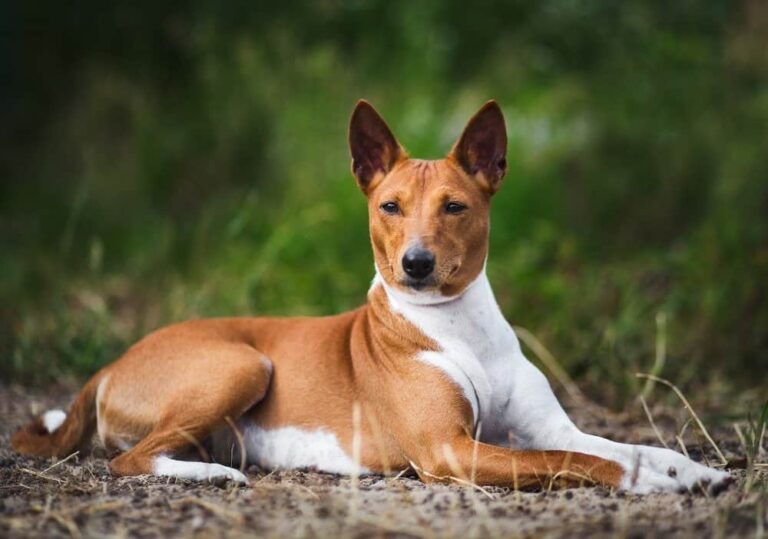Purebred Basenji Dog Breed Information
The Basenji is a unique dog breed from Central Africa, known as the African Barkless Dog due to its inability to bark like other dogs. Instead, it communicates with a distinctive sound that resembles a chortle or yodel. The Basenji was initially bred to flush wild game into nets for hunters. Its particular throat structure is what prevents it from barking.
These dogs are valued for their intelligence and clean nature, making them attractive to dog lovers. They are also known for being independent and requiring much exercise. This can be a challenge for anyone thinking about getting a Basenji. They need an owner who understands their exercise needs and respects their independent streak.
Their behavior and care needs mean they are not the best fit for every home. It’s essential to consider how a Basenji would fit into your life before deciding to bring one into your family.
Key Takeaways
- The Basenji is a non-barking, Central African dog.
- Known for intelligence and cleanliness, Basenjis attracts enthusiasts.
- Exercise and independence are critical to Basenji ownership.
Quick Facts
The Basenji, a small dog hailing from Central Africa, is known for its quiet nature, as it doesn’t bark due to its unique throat structure. Instead, it can produce a range of sounds, including a yodel, which makes it stand out from other dogs. Averaging 16 to 17 inches in height and weighing between 22 and 24 pounds, the Basenji is a member of the sighthound family. It is recognized for its curled tail and streamlined build, reflecting its history as an agile hunter.
Living generally between 12 and 16 years, Basenjis need consistent veterinary care to check for conditions like Fanconi Syndrome and hip dysplasia. They need about 40 minutes of exercise daily, plus stimulating activities to keep their minds sharp and prevent unwanted behaviors. These dogs often form close relationships with their families but can be standoffish with new people or animals. That’s why starting socialization and training early for a well-adjusted pet is vital.
Basenji Dog Breed Information Pictures
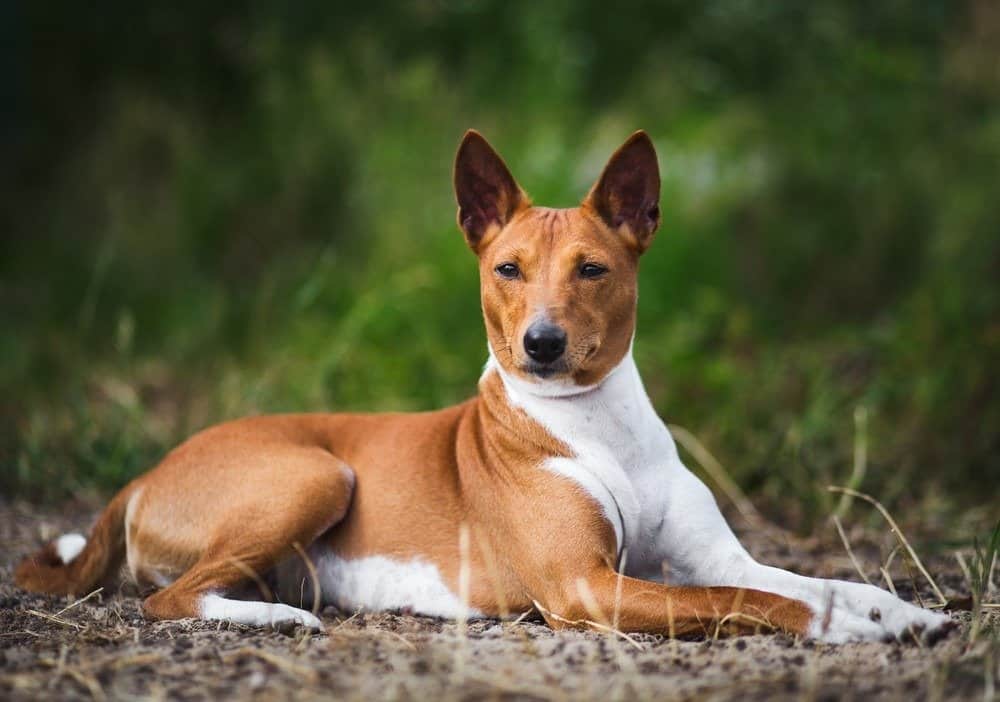
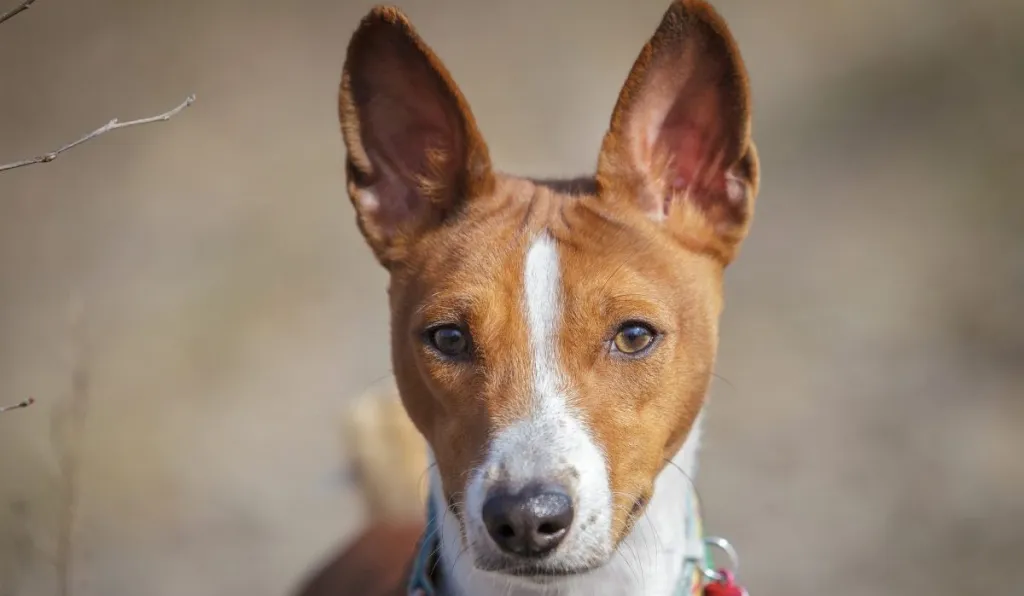
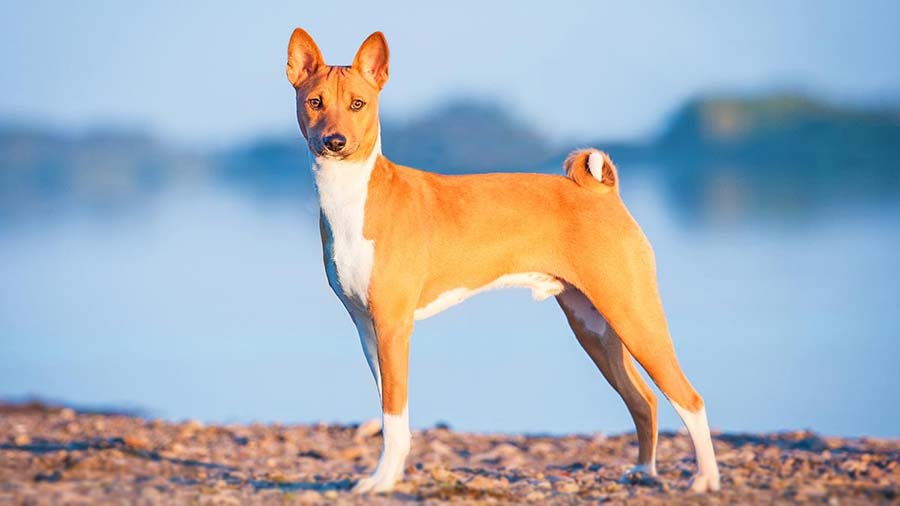
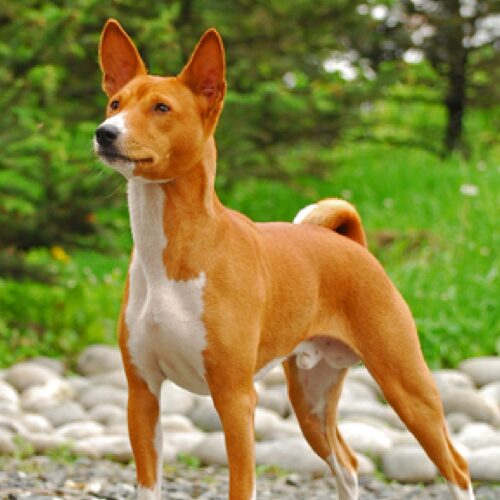
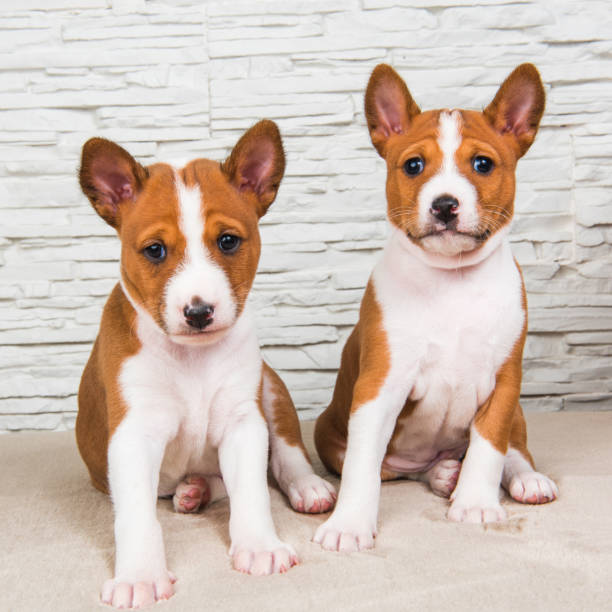
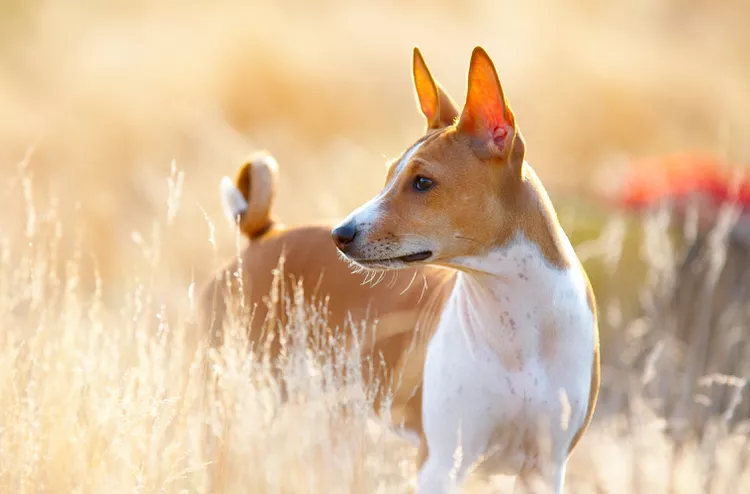
Overview
Building upon the essential features of the Basenji, this piece offers insights into the breed’s origins, behavior, and care needs.
Originating from Central Africa, the Basenji is a member of the Hound Group known for its longevity, spanning 12-16 years. Standing 16-17 inches at the shoulder and weighing 22-24 pounds, the breed is distinguished by a curled tail and erect ears, which give it an attentive and graceful appearance.
The Basenji is competent and self-reliant, known for not barking, which makes it resemble a cat in its cleanliness. These dogs need physical activity and mental stimulation to keep them content. Training them requires a steady approach and patience, as they respond well to positive reinforcement.
Their short coat is easy to care for, but Basenjis are prone to Fanconi Syndrome and hip dysplasia, so regular vet check-ups are crucial. They can live in an apartment if they get enough exercise. However, Basenjis can be a handful for first-time dog owners. Socializing and training them early ensures they get along well with other pets and family members.
Barkless Breed Traits
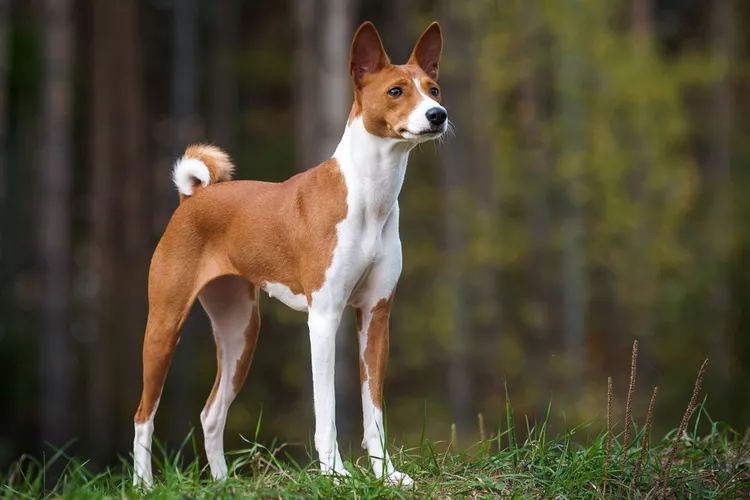
The canine Basenji breed stands out for its unique communication method, as it doesn’t bark like most dogs. Instead, these dogs have their vocalizations, including yodels, chortles, and what could be described as crowing. They’re mainly known for a sound called a ‘baroo,’ which is a kind of yodel they make when they’re excited or happy, and it’s something that people who love Basenjis find pretty charming.
| Trait | Description | Emotion Evoked |
|---|---|---|
| Yodel-Like Sound | A distinct vocalization that sets them apart from other dogs. | Amusement, Curiosity |
| Cleanliness | They groom themselves much like cats do. | Admiration, Appreciation, Affectionate |
| Prey Drive & Energy | They are active and need lots of exercise. | Respect for their athletic nature |
Understanding these traits is crucial when considering a Basenji as a pet. Their communication style is more than just a quirk; it’s a different way of interacting that potential owners should appreciate. Their cat-like grooming habits mean they’re cleaner than many other breeds, which can be a plus for people with allergies. However, their high energy levels and prey drive stem from their hunting background, so they need an owner to provide them with plenty of exercise and mental stimulation. Basenjis are independent and intelligent, so they benefit from training that is both consistent and engaging. It’s also essential to keep up with regular vet check-ups to prevent issues like Fanconi syndrome and hip dysplasia, which can affect this breed.
Ancient African Origins
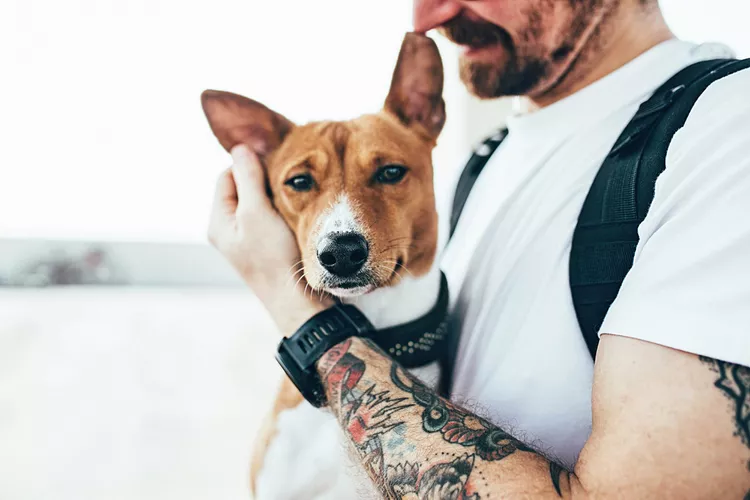
The Basenji breed has a rich history that begins in the depths of the central African forests. It is mainly linked to the Congo area, where it served as a hunting partner. This breed stands out because of its genetic background, which shows that Basenjis are some of the earliest dogs to be domesticated. They also had a notable role in ancient Egyptian civilization, evidenced by the art and records.
- The Basenji hails from the dense forests of central Africa, with a solid connection to the Congo, where it was valued for its hunting skills.
- With a genetic heritage that dates back to the dawn of dog domestication, the Basenji is recognized as one of the oldest dog breeds.
- Ancient Egypt celebrated the Basenji, as seen in numerous artistic works and historical documents.
Origin in Africa
With its roots in Central Africa, particularly around the Congo basin, the Basenji is a dog breed steeped in history, existing long before many breeds we know today.
Genetic studies show that despite being from Africa, the Basenji shares a close relationship with the Asian spitz dogs, hinting at an intricate evolutionary past.
European explorers first encountered the Basenji in the Congo around 1895, but initial attempts to bring the breed to England were unsuccessful due to disease issues.
It wasn’t until the 1930s that the Basenji breed was successfully integrated into Western dog populations, achieving recognition by the American Kennel Club (AKC) in 1943.
The American Kennel Club’s decision to reopen its stud book for the Basenji between 2009 and 2013 is a testament to the breed’s lasting appeal and the continuous effort to conserve its distinctive genetic makeup and rich history.
Basenji Breed Ancestry
Research into the Basenji breed shows it to be one of the earliest types of dog. It has kept its original traits for a very long time.
Known to be one of the most ancient dog breeds, the Basenji is traced back to the heart of Africa, particularly around the Congo. Genetic studies link the Basenji closely with the spitz breeds from Asia, indicating its genetic makeup has mainly stayed the same for a long time.
Europeans first wrote about the breed in 1895, noting its lack of a typical bark and distinctive square shape. Despite its long history, the breed wasn’t added to the American Kennel Club’s registry until 1943.
Key points of the Basenji include its enduring nature, common health issues, and easy grooming, all of which highlight its old origins.
Historical Significance
To truly appreciate the Basenji’s role in the history of domesticated dogs, one must consider its origins in Central Africa’s Congo Basin. The breed is a cornerstone in the study of early dog lineages. The Basenji is one of the oldest breeds, sharing solid genetic ties with the dingo, which speaks volumes about its place in the domestication story of dogs.
Originating as a hunting dog, the Basenji was documented by European explorers in 1895. Its breed traits were well-defined by the 1930s in England and the United States.
The American Kennel Club recognized the Basenji in 1943, solidifying its reputation as a heritage breed. Genetic research links the Basenji to the Spitz family from Asia, providing deeper insights into its background. The AKC’s occasional reopening of its stud book for new Basenji imports shows a commitment to maintaining the breed’s rich historical and genetic makeup.
Compact Build Proportions
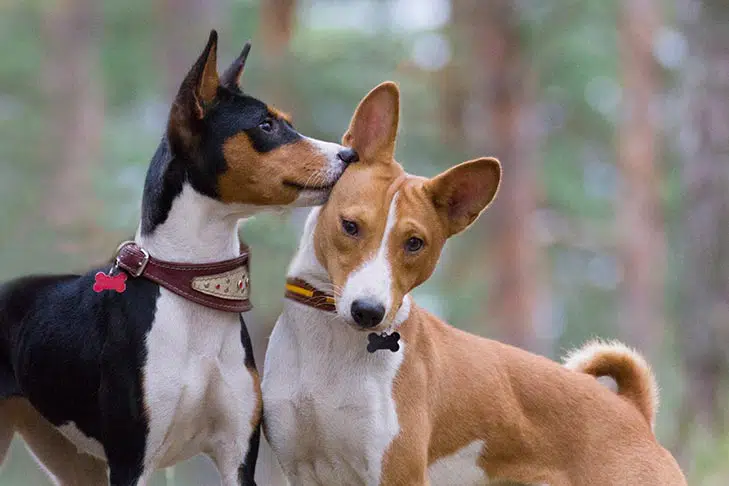
The Basenji breed is known for its compact size, which perfectly suits apartment living. These dogs adapt quickly to smaller spaces, making them great pets for city dwellers.
Their athletic build lends them a remarkable blend of speed and stamina. This physical composition allows Basenjis to move with a graceful elegance that’s pleasing to watch and functional for various activities.
The breed’s physical traits align with the recognized standards, making them popular as pets and show dogs. Understanding these characteristics is critical to appreciating the breed’s versatility and how they thrive in different environments.
Ideal Apartment Size
Standing at just 16 to 17 inches and weighing a modest 22 to 24 pounds, Basenjis are perfect pets for those living in apartments. Their small size makes them easy to manage in tighter spaces. While energetic, these dogs can thrive in smaller homes with enough exercise and mental stimulation.
Regular walks and playful activities keep them healthy and happy, eliminating the need for a spacious home. Basenjis also have low grooming needs, which is another reason they fit well in apartments. With the right amount of play and interaction, these dogs are great for those with less living space.
Athletic Physical Structure
Basenjis are great for living in apartments due to their size and energy levels. They stand about 16 to 17 inches tall and weigh 22 to 24 pounds, making them a perfectly compact size.
Their bodies are well-proportioned and robust, which helps them move quickly and with agility. Initially bred for hunting, Basenjis have a natural tendency to chase, thanks to their quick reflexes and enduring stamina.
This breed’s well-muscled frame allows them to excel in activities that require bursts of speed and the ability to turn on a dime. Their endurance is also a significant factor, enabling them to participate in various dog sports and handle extensive exercise routines.
Keeping Basenji mentally and physically stimulated is vital to their well-being, as they are naturally energetic and curious.
Graceful Movement Traits
Basenjis move with a natural elegance, their athletic bodies allowing for swift and agile steps. These dogs stand between 16 and 17 inches tall and tip the scales at 22 to 24 pounds. Their square build and even proportions contribute to their stylish look and ability to move quickly.
Basenjis have a compact and well-proportioned frame that supports their fluid and effective movements, showcasing their agility and grace.
Their upright ears add to their vigilant and lively character. The Basenji’s sleek proportions and smooth movement enhance their visual charm, making them excellent at various dog sports and agility-based tasks.
Unique Body Characteristics
The Basenji breed is known for its compact size and square shape, making it exceptionally balanced and agile, which is perfect for high-energy activities. Male Basenjis typically stand between 16-17 inches tall and weigh 22-24 pounds, while females are slightly smaller, usually standing below 16 inches and weighing 20-22 pounds.
This breed’s muscular build belies its strength, and when combined with an elegant neck, perky ears, and a curled tail, it presents an athletic figure. The short coat adds to the Basenji’s streamlined look.
These physical traits are not just for show; they make the Basenji excellent in dog sports and reflect their past as effective hunting dogs, adept at performing in challenging environments.
Breed Standard Measurements
Basenji dogs are known for their lean, athletic frames. Males stand at an ideal height of about 17 inches and weigh around 24 pounds. Conversely, females are generally smaller, typically standing 16 inches tall and weighing nearly 22 pounds.
The Basenji Club of America outlines that these dogs should have a balanced, square body shape. This design contributes to their agility, allowing these dogs to move quickly and gracefully. The balance of height to weight is crucial in maintaining the breed’s well-known athletic abilities, ensuring they can move swiftly and precisely.
Factors to Consider: Quiet Nature
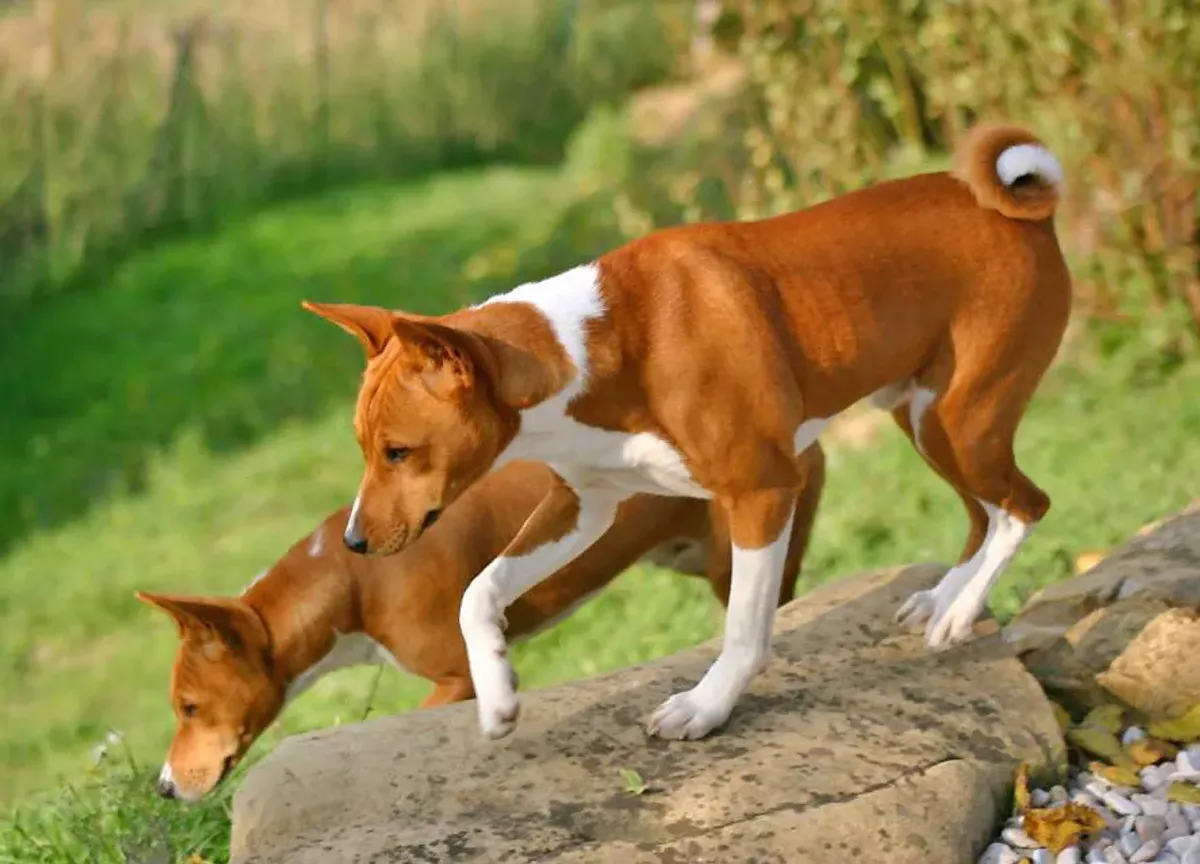
The Basenji dog breed stands out due to its unusual quietness compared to other dogs, notably because it doesn’t bark like they do. Their distinct sounds play a significant role when interacting with and training Basenji.
Owners who prefer a calm environment might find the Basenji’s silence a significant plus. To properly care for them, it’s critical to understand how Basenjis communicate without barking.
This review will shed light on the effects of Basenji’s reserved behavior on interactions and how it fits into a family setting.
Basenji Vocal Characteristics
Basenji dogs are unique because they don’t bark much but make interesting sounds like yodels. Their quiet nature is perfect for apartment living. They are also spotless animals, grooming themselves like cats.
While they might seem reserved, they show excitement with unique sounds. Owners should know about health issues like progressive retinal atrophy that can affect Basenjis.
Communicating Without Barking
Basenji dogs are known for their unique sounds, like yodeling, instead of the familiar barking of other breeds. Known as quiet dogs, they’re ranked number 61 by particular dog enthusiasts.
Basenjis are meticulous groomers, much like cats, and this trait is reflected in how they communicate. They are independent and need consistent training with rewards to manage their silence.
These dogs have a strong prey drive but can be headstrong. Keeping them mentally stimulated during activities helps maintain their peace. Basenjis are also very observant and may watch their surroundings quietly for long periods. They make calm and watchful pets.
Training for Quietness
Understanding how Basenjis naturally prefer quiet lays the groundwork for effective training techniques encouraging their silence.
Positive reinforcement in dog training is essential; rewarding your Basenji when calm reinforces their silent behavior. Consistent and patience are critical; they help the dog connect between being quiet and getting rewards.
To keep the Basenji from getting bored and making noise, it’s essential to provide them with interactive toys that keep their mind engaged.
If a Basenji starts reacting to certain noises or situations with barking, slowly getting them used to these triggers can help reduce this behavior. This technique is known as desensitization.
However, if these training methods aren’t enough, starting socialization early or seeking help from a certified dog trainer might be necessary to manage persistent barking effectively.
Understanding Basenji Sounds
The unique vocal array of the Basenji sets it apart from the typical barking dog. This breed is known for its distinctive yodels, chortles, and a sound similar to crowing rather than the usual dog bark.
A Basenji communicates through these unusual sounds, whether a pup or a grown dog. This is how they express their emotions and intent.
The Basenji’s relatively silent nature is a plus in places like apartments where keeping noise to a minimum is essential. Owners will benefit from learning these vocal cues. Understanding them is critical to meeting the dog’s needs.
A strong bond between a Basenji and its owner depends on this knowledge, allowing them to live together in harmony.
Silence in Breed Nature
The Basenji breed is known for being exceptionally quiet, as they rarely bark. This silence isn’t a sign of a lack of enthusiasm; instead, the Basenji communicates excitement with yodel-like sounds. These dogs are usually reserved around new people, demonstrating their calm nature.
While they don’t bark, Basenjis are always alert, making them good watchdogs. Their independent nature may be why they’re so quiet, which is perfect for people who want a more subtle pet companion.
Owners should be aware of potential health issues, like Fanconi syndrome, which can affect the breed’s well-being.
Basenji’s quietness is appreciated by many looking for a calm dog. They express themselves with unique vocalizations and maintain an alert demeanor. They are independent, suiting owners who prefer a less demanding pet. People interested in this breed should learn about conditions like Fanconi syndrome to ensure proper care.
Genetic Health Considerations
When looking into the Basenji dog breed, prospective owners and breeders need to be aware of specific common health issues and temperament traits in these dogs. These issues can affect both the well-being and the lifespan of the dog.
Here are some key health risks to keep in mind:
- Fanconi Syndrome: A hereditary kidney disease that requires careful management. Owners must monitor for signs and work closely with a vet for proper care.
- Hereditary Illnesses: Basenjis may suffer from a range of genetic conditions. It’s critical to stay informed and to seek preventative measures to ensure the dog’s health.
- Lifespan and Genetics: The genetic makeup of a Basenji can influence its life expectancy. Responsible breeding can help mitigate health risks and promote a longer, healthier life for these dogs.
Understanding these health risks is essential for maintaining the well-being- of a Basenji. Regular vet check-ups and responsible breeding practices are crucial to preventing and managing these genetic conditions.
Fanconi Syndrome Risk
Basenji dogs are prone to a genetic condition called Fanconi Syndrome. This disease hampers the kidneys’ function regarding nutrient and electrolyte absorption. Symptoms usually appear when dogs are between 4 and 8 years old and can cause serious health problems like dehydration and glucose in the urine despite normal blood sugar levels.
Owners of Basenji dogs need to watch their pets closely for signs of Fanconi Syndrome because it can severely affect kidney health and the dog’s quality of life. Breeders are working to decrease the number of dogs born with this autosomal recessive condition.
Genetic tests can help identify the syndrome early, vital for proper care and management. It’s critical for those who have Basenjis to recognize the symptoms early to ensure their pets stay healthy.
Common Basenji Ailments
Basenjis are prone to specific health issues, including hip dysplasia, which is an inherited condition where the hip joint doesn’t form properly. This can cause pain and difficulty in movement. Responsible breeders should conduct genetic tests to reduce the chances of this condition in their puppies.
These dogs can also develop Pyruvate Kinase Deficiency, leading to anemia and weakness due to the abnormal breakdown of red blood cells. Another hereditary condition to watch for is Progressive Retinal Atrophy, which can deteriorate a dog’s eyesight over time and may result in blindness. Regular vet check-ups are crucial to catch any early signs of these conditions.
In addition to these, Basenjis can be affected by Umbilical Hernias. This is where part of the intestine protrudes through the abdominal wall. It’s essential to check for this during routine health examinations.
Keeping up with regular vet visits is vital for maintaining the health of a Basenji.
Lifespan and Heredity Factors
Prospective Basenji owners and breeders must be aware of the health issues affecting these dogs. Basenjis typically live between 12 to 16 years, with an average lifespan of around 13.6 years. They’re known for their overall health but can inherit certain conditions, so watching for these is essential.
For instance, Fanconi syndrome is a kidney disorder that can affect Basenjis, and early detection through regular urine tests can make a big difference.
These dogs can also suffer from other health issues, including hip dysplasia, skin problems, urinary incontinence, bladder infections, thyroid issues, and pyometra, which is an infection of the uterus. Regular check-ups with a vet can help catch and manage these problems early on.
Keeping up with veterinary care is crucial in helping a Basenji live a long and healthy life. It’s how a Basenji can potentially become one of the oldest in its breed.
Grooming Essentials
A regular grooming schedule is vital to keeping your Basenji looking and feeling great. Here’s what you need to know to take the best care of your pup’s coat and skin:
Regular nail trimming is necessary to avoid any discomfort or issues with walking. This breed can suffer if their nails get too long. Make sure to cut their nails often enough to keep them short and comfortable.
Keeping a Basenji’s ears clean is vital. Without regular cleaning, these dogs can quickly develop ear infections. Set aside weekly time to clean their ears gently to prevent health problems.
Bathing your Basenji should be guided by their play and exercise habits. This breed doesn’t need frequent baths, but wash them as needed to keep their coat healthy. This approach helps preserve the natural oils in their skin.
This grooming routine will ensure your Basenji stays happy, healthy, and best-looking.
Basenji Coat Care
Maintaining a Basenji’s coat is simple due to its short, delicate texture. A weekly wipe-down with a soft cloth is enough to remove loose hair. Brushing the dog occasionally keeps their coat smooth and shows off their tricolor, black and white coloring.
Keeping their ears clean and their nails trimmed for overall health is also vital. Basenjis don’t need frequent baths because they groom themselves well and don’t smell bad.
Don’t forget about their teeth, though—regular brushing keeps dental problems at bay.
Bathing Frequency
Basenji dogs are known for their low-maintenance grooming needs due to their short coats that naturally stay clean. They only need a complete bath every few months as they don’t collect much dirt or develop bad smells. Regular brushing and a quick wipe-down keep their coats in good shape.
Basenjis also groom themselves in a way that’s similar to cats, which helps them stay clean. Other grooming, such as nail trimming and teeth cleaning, should be done regularly. It’s best to start these habits early so the dog gets used to them.
Nail Trimming Tips
Keeping a Basenji’s nails trimmed is vital for their health, and using sharp, quality clippers can make the process smoother and less aloof. Starting nail decorating early with a Basenji can help them get used to it, which makes them less anxious about grooming.
It’s crucial to avoid cutting the nail’s blood supply to prevent pain and bleeding. You can see the brief as pink if the nail is clear. With dark nails, trim carefully and stop if you see a small dark dot that indicates you’re near the quick.
Giving treats during nail trimming can make it a more positive experience for your Basenji and easier for you.
When trimming a Basenji’s nails, looking for a quick to avoid causing injury is essential. The fast is visible with clear nails as a pink section, but with dark nails, it’s harder to spot, so trim little by little. Watch for a tiny dark circle that shows you’re getting close to the quick.
Rewarding your Basenji with treats helps them feel good about nail trims, making the task more accessible for the dog and the owner.
Ear Cleaning Guide
Keeping your Basenji’s nails trimmed is essential for paw health, just as cleaning their ears is essential to avoid infections and keep them healthy.
Use a vet-recommended ear cleaner to wash your Basenji’s ears and avoid discomfort gently. To clean the ears, lift the flap gently, apply a few drops of cleaner, and rub the base to loosen any buildup. The dog will shake its head, helping to remove wax and debris. Then, use a cotton ball to wipe the part of the ear you can see.
Always look for any signs of discomfort or infection in your dog. Regular ear cleaning is a critical part of your dog’s care routine.
Brushing Techniques
Regular brushing is vital to keeping your Basenji’s coat healthy and looking good. Use a soft-bristled brush to remove loose hair and prevent tangles gently. Brushing once weekly is usually enough to handle their shedding and smooth their coat. Be extra careful when you touch their belly and legs, as these areas are more sensitive.
Positive feedback during grooming sessions can make the experience better for your dog. Along with brushing, it’s essential to check their ears, trim their nails, and brush their teeth. These steps are vital for their overall health and mirror the Basenji’s natural grooming habits.
Dietary Requirements
Basenji dogs have specific dietary needs to support their energetic lifestyle. They require a diet rich in high-quality proteins and the right calories to keep up with their fast metabolism.
When choosing food for a Basenji, it’s important to pick options that offer a good mix of protein, carbs, and fats while avoiding ingredients that might trigger allergies.
To maintain Basenji’s health and prevent weight gain, monitoring how much and what they eat is essential.
Basenji Nutritional Needs
Catering to the dietary needs of Basenjis helps keep them healthy and full of vitality. These energetic dogs do well on a protein-rich diet to maintain strong muscles. For steady energy, they should eat lean meats, good fats, and complex carbs.
It’s important to watch their food intake to avoid weight gain, as Basenjis can easily overeat. A good measure is about 3/4 to 1 cup of quality dry dog food each day, split into two meals.
Since Basenjis can develop conditions like Fanconi syndrome, which affects the kidneys, talking to a vet about food that supports kidney health is a good move. Always ensure they have access to clean water to help keep their kidneys and overall health in tip-top shape.
Ideal Food Choices
When choosing the best diet for Basenjis, selecting high-quality dog food that meets their needs is essential. Look for food that supports their energy levels and is appropriate for their size.
Basenjis benefit from a diet rich in lean proteins to keep up with their active nature and to help build strong muscles. These proteins should be full of the essential amino acids that dogs need.
It’s also important to include healthy fats in their diet, like omega-3 and omega-6 fatty acids, to keep their coat shiny and their skin healthy. Good digestion is supported by ensuring their food has enough fiber, which can also help prevent digestive problems that Basenjis might be prone to.
Watching their food intake is vital to avoid obesity, especially since Basenjis have a moderate level of activity and can quickly gain weight if they overeat.
Managing Weight & Health
Keeping male Basenjis at a healthy weight, between 22 and 24 pounds, and females between 20 and 22 pounds, is essential for their well-being. This requires close attention to their diet and sticking to measured meals.
A nutritious diet for these dogs includes premium dry food, with adults typically needing about 3/4 to 1 cup each day, split over two feedings. Adjust the food quantity based on the dog’s exercise level and unique metabolism to help manage their weight effectively.
Regular physical activity, like daily walks and activities that challenge their minds, is vital for Basenjis. These activities help maintain their weight and contribute to their overall health.
Treats should be low in calories and included within the daily food allowance to keep the diet balanced. Regular check-ups with the vet and monitoring the dog’s body condition are essential to tailor a diet that supports their health and longevity.

